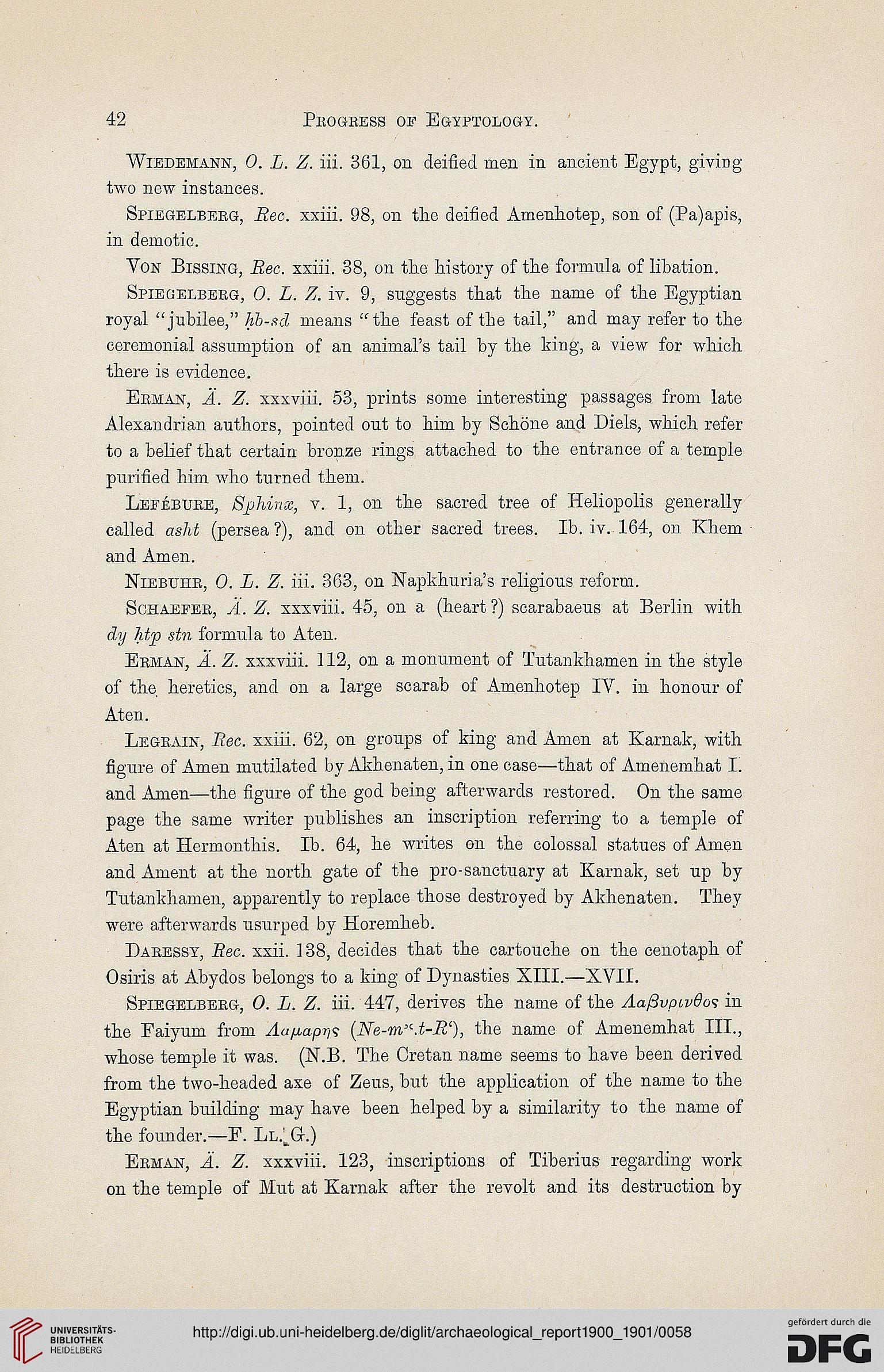42
Pbogbess of Egyptology.
Wiedemann, 0. L. Z. iii. 361, on deified men in ancient Egypt, giving
two new instances.
Spiegelbeeg, Rec. xxiii. 98, on the deified Arnenliotep, son of (Pa)apis,
in demotic.
Von Bissing, Rec. xxiii. 38, on the history of the formula of libation.
Spiegelbeeg, 0. L. Z. iv. 9, suggests that the name of the Egyptian
royal "jubilee," hh-scl means "the feast of the tail," and may refer to the
ceremonial assumption of an animal's tail by the king, a view for which
there is evidence.
Eeman, A. Z. xxxviii. 53, prints some interesting passages from late
Alexandrian authors, pointed out to him by Schone and Diels, which refer
to a belief that certain bronze rings attached to the entrance of a temple
purified him who turned them.
Lefebube, Sphinx, v. 1, on the sacred tree of Heliopolis generally
called asht (persea ?), and on other sacred trees. Ib. iv. 164, on Khem
and Amen.
Niebuhb, 0. L. Z. iii. 363, on Napkhuria's religious reform.
Schaefee, A. Z. xxxviii. 45, on a (heart?) scarabaeus at Berlin with
dy Mp stn formula to Aten.
Eeman, A. Z. xxxviii. 112, on a monument of Tutankhamen in the style
of the heretics, and on a large scarab of Arnenliotep IV. in honour of
Aten.
Legeain, Rec. xxiii. 62, on groups of king and Amen at Karnak, with
figure of Amen mutilated by Akhenaten, in one case—that of Amenemhat I.
and Amen—the figure of the god being afterwards restored. On the same
page the same writer publishes an inscription referring to a temple of
Aten at Hermonthis. Ib. 64, he writes on the colossal statues of Amen
and Anient at the north gate of the pro-sanctuary at Karnak, set up by
Tutankhamen, apparently to replace those destroyed by Akhenaten. They
were afterwards usurped by Horemheb.
Daeessy, Rec. xxii. 138, decides that the cartouche on the cenotaph of
Osiris at Abydos belongs to a king of Dynasties XIII.—XVII.
Spiegelbeeg, 0. L. Z. iii. 447, derives the name of the Aa/3vpiv8o<; in
the Faiyum from Aa^apr^ (Ne-m".t-Rl), the name of Amenemhat III.,
whose temple it was. (iST.B. The Cretan name seems to have been derived
from the two-headed axe of Zeus, but the application of the name to the
Egyptian building may have been helped by a similarity to the name of
the founder.—F. Ll.'^G-.)
Eeman, A. Z. xxxviii. 123, inscriptions of Tiberius regarding work
on the temple of Mut at Karnak after the revolt and its destruction by
Pbogbess of Egyptology.
Wiedemann, 0. L. Z. iii. 361, on deified men in ancient Egypt, giving
two new instances.
Spiegelbeeg, Rec. xxiii. 98, on the deified Arnenliotep, son of (Pa)apis,
in demotic.
Von Bissing, Rec. xxiii. 38, on the history of the formula of libation.
Spiegelbeeg, 0. L. Z. iv. 9, suggests that the name of the Egyptian
royal "jubilee," hh-scl means "the feast of the tail," and may refer to the
ceremonial assumption of an animal's tail by the king, a view for which
there is evidence.
Eeman, A. Z. xxxviii. 53, prints some interesting passages from late
Alexandrian authors, pointed out to him by Schone and Diels, which refer
to a belief that certain bronze rings attached to the entrance of a temple
purified him who turned them.
Lefebube, Sphinx, v. 1, on the sacred tree of Heliopolis generally
called asht (persea ?), and on other sacred trees. Ib. iv. 164, on Khem
and Amen.
Niebuhb, 0. L. Z. iii. 363, on Napkhuria's religious reform.
Schaefee, A. Z. xxxviii. 45, on a (heart?) scarabaeus at Berlin with
dy Mp stn formula to Aten.
Eeman, A. Z. xxxviii. 112, on a monument of Tutankhamen in the style
of the heretics, and on a large scarab of Arnenliotep IV. in honour of
Aten.
Legeain, Rec. xxiii. 62, on groups of king and Amen at Karnak, with
figure of Amen mutilated by Akhenaten, in one case—that of Amenemhat I.
and Amen—the figure of the god being afterwards restored. On the same
page the same writer publishes an inscription referring to a temple of
Aten at Hermonthis. Ib. 64, he writes on the colossal statues of Amen
and Anient at the north gate of the pro-sanctuary at Karnak, set up by
Tutankhamen, apparently to replace those destroyed by Akhenaten. They
were afterwards usurped by Horemheb.
Daeessy, Rec. xxii. 138, decides that the cartouche on the cenotaph of
Osiris at Abydos belongs to a king of Dynasties XIII.—XVII.
Spiegelbeeg, 0. L. Z. iii. 447, derives the name of the Aa/3vpiv8o<; in
the Faiyum from Aa^apr^ (Ne-m".t-Rl), the name of Amenemhat III.,
whose temple it was. (iST.B. The Cretan name seems to have been derived
from the two-headed axe of Zeus, but the application of the name to the
Egyptian building may have been helped by a similarity to the name of
the founder.—F. Ll.'^G-.)
Eeman, A. Z. xxxviii. 123, inscriptions of Tiberius regarding work
on the temple of Mut at Karnak after the revolt and its destruction by




